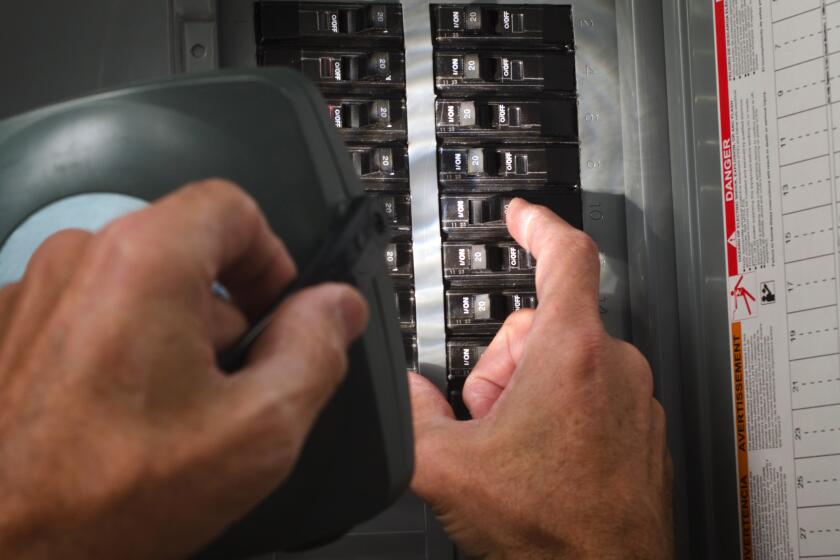Copter Crash Investigation Focuses on Mechanics : Aeronautics: Probers want to know if maintenance crew failed to properly respond to a warning bulletin from the manufacturer of the police craft.
City officials said Wednesday they are investigating whether mechanics failed to respond properly to a warning about a crucial part that may have failed moments before last month’s fatal crash of a Los Angeles police helicopter.
A manufacturer’s emergency bulletin, issued in 1990, called for modification of some of the “freewheel shaft assemblies” on Aerospatiale 350 B1 helicopters by last October.
A Police Department 350 BI crashed in Southwest Los Angeles on June 13, killing the two officers on board and a civilian on the ground.
A manufacturer’s telex dated July 2 says “it was noted that the freewheel fitted on the helicopter (that crashed) . . . was not compliant with the directives” of the emergency bulletin.
Joe Trevgoda, assistant director of the city’s Department of General Services--which maintains and repairs the Los Angeles Police Department’s fleet of 19 aircraft--said Wednesday that an audit is under way to determine whether the helicopter had one of the faulty freewheel units, whether the bulletin was ignored and, if so, why.
Elly Brekke, a spokeswoman for the Federal Aviation Administration, said that although compliance with such bulletins is mandatory for commercial carriers under federal law, public agencies, such as the city of Los Angeles, are permitted to treat them as advisory.
The freewheel unit is part of the drive train that ties a helicopter’s engine to the main rotor, which provides lift.
Helicopter experts explained Wednesday that the unit allows the rotor to spin freely in the event of engine failure, permitting the pilot to make a safe, soft landing through a maneuver known as “auto rotation.” They said that if the unit is not working properly, the maneuver is difficult.
Although the precise cause of the June 13 accident has yet to be determined, it is known that the crew reported engine failure seconds before the craft crashed and burned in a parking lot, killing pilot Gary Howe, observer Charles R. (Randy) Champe and furniture salesman Lino Daniel Falquero.
Trevgoda said he has been told that a preliminary police investigation has shown that the freewheel unit malfunctioned after the engine failure.
Capt. Robert Woods, commander of the Police Department’s Air Support Division, said he had received orders Wednesday not to comment on the matter. However, in a published report, Woods was quoted Wednesday as saying that “the freewheeling unit did malfunction. . . . We know that when the freewheeling unit let go, that’s what initiated the incident.”
The original emergency bulletin was issued in April, 1990, by the Aerospatiale Helicopter Co., a French firm that manufactures the airframes of the craft, and Turbomeca Engine Corp., a French company that builds the engines. Both companies have U.S. headquarters in Grand Prairie, Tex.
The bulletin said that, because of “slippage” in some freewheel units, operators of helicopters equipped with them should “modify the freewheel shaft assemblies . . . as soon as possible, on 31 October, 1990, at the latest.”
Dick Hart, president of National Helicopter Service, an authorized Aerospatiale/Turbomeca repair service at Van Nuys Airport, said he handled three helicopters affected by the bulletin.
“We removed the parts, sent them to Turbomeca, they modified them and sent them back,” Hart said. “They paid for everything.”
On June 10--three days before the fatal crash--Turbomeca issued an informational letter from its headquarters in Bordes, France, advising that, during certain pre-delivery tests, friction was causing overheating that “leads to a deterioration which can cause a defective operation of the freewheel.”
The company said it was conducting tests to determine the cause of the “excessive rubbing.”
On July 10, the Police Department grounded its entire fleet of helicopters “as a safety precaution.” Police spokesman Lt. Fred Nixon declined to explain why, saying only that “we are trying to be absolutely certain that we have checked out every possible safety issue.”
The grounding came eight days after another Aerospatiale/Turbomeca telex was sent to all authorized repair facilities. It read in part:
“An AS 350 B1 helicopter was recently involved in an accident in the U.S.A. Without prejudicing the conclusions of the inquiry, it was noted that the free wheel fitted on the helicopter . . . was not compliant with the directives of Turbomeca.”
Carey Brown, a Turbomeca official, confirmed Wednesday that the helicopter mentioned in the telex was the one that crashed here June 13.
Brown and other Turbomeca officials declined further comment Wednesday. Officials from Aerospatiale could not be reached.
More to Read
Sign up for Essential California
The most important California stories and recommendations in your inbox every morning.
You may occasionally receive promotional content from the Los Angeles Times.






